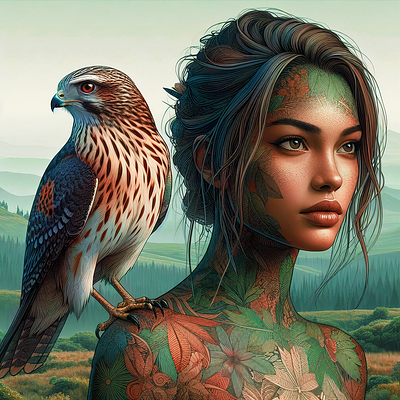Hello, fellow Pixels,
In the world of art, creating a narrative is an effective way to connect your artwork or tie together a common theme in your brand. Doing this gives you a "soul" to your colors, structures, forms, and other artistic elements. Each and every pixel has the potential to influence the story you're trying to tell, no matter your skill level as an artist. This edition aims to emphasize the importance of finding that narrative to make your impact and appeal more recognizable.
Ensure to stay until the end to find out about a private event available to our community only related to this topic!

Narrative art adds additional layers to traditional storytelling. The visual aspects aid in creating a scene dialogue, provoking thought in the viewer's imagination. Each addition to the narrative slowly builds the storyline and allows viewers to step into your custom world one foot at a time. The interest in your narrative helps provoke questions, engagement, and exploring the deeper meaning behind the work, which in its own way helps build the narrative surrounding your art through community engagement.
Creating Narrative in Your Art

Define Your Story: Pinpointing the story or concept you want to narrate is an essential first step. You can use your personal experiences, historical events, myths, abstract concepts, or a story from a book you read in the 3rd grade. This choice will help you decide what emotions you are aiming to show. For instance, Vincent van Gogh's "Starry Night" conveys his inner turmoil and hope beyond just a beautiful night sky.
Choose Your Moment: Focusing on a significant moment can strengthen viewers' intellectual or emotional reactions. Consider this to be like choosing a scene from a film or artwork that resonates with you due to its emotional or narrative climax, such as the reunion scene in "Shawshank Redemption" or "The Sad Message" by Peter Fendi. These scenes should depict specific implications about the past or future and convey other overarching themes.

Develop Your Characters and Setting: Who populates your story? If you place characters in your story, what defines them (e.g., traits, personality, stage on their personal journey, what do they look like)? What are their emotional states? How do the surroundings add to or contrast with those aspects? Place these characters in a setting that enhances the narrative. The settings are as central to the narrative as the characters themselves. They provide context and mood from several variables such as lighting, scene(e.g., castle or dark swamp), dark/bright colors, and more. A strong example of this would be Frida Kahlo's "Without Hope," which uses an eerie, endless background, tears on her face, and a funnel of meat into her mouth to add depth to the distressing narrative.

Composition and Focus: Using various elements such as lines, contrasting lights/colors, and positioning of focal points can strategically draw attention to the essential parts of your piece. Johannes Vermeer, the artist behind "Girl with a Pearl Earring," is a well-known artist famed for his ability to use light and color to focus the viewer's attention. However, another way to look at the application of this is Jackson Pollock's work through abstract expressionism in pieces such as "Number 1, 1950 (Lavender Mist)."
Add Layers of Meaning: Employing symbols, motifs, and color palettes can emphasize the narrative. They will help add depth, change the story, and invite interpretation from the viewers. "The Lovers" by Renee Magritte uses shrouds over the lover's faces to convey people's inability to genuinely show themselves while adding to the narrative with a darker palette.
Leave Space for the Viewer: Narrative art allows for the viewers' active engagement for enjoyment and interpretation. While your vision for the piece might be precise, letting viewers bring their perspectives and insights into the act will foster a personal connection with the piece. Edward Hopper's piece "Nighthawks" shows an American diner with a few patrons. It's a simple depiction, yet there are a million perspectives. Personally, it has always reminded me of life's burdens and to enjoy the memories of late nights with lost friends.

Practical Tips for Narrative Artists
Practice Regularly: This can be said in billions of ways, but one has always been the best: Practice! Practice! Practice!
Study Masterpieces: Explore the works of the masters! History is a treasure trove of artists from which you can find inspiration and lessons. Many have been named above, and more can still be named, such as Caravaggio, Ai Weiwei, Beeple, Sam Spratt, comic books, and many more options. Videos on YouTube, documentaries on TV, and books online and in the library are all viable sources to find knowledge.
Experiment with Media: Explore beyond your comfort zone by experimenting with artistic mediums outside your norm, such as digital art, photography, mixed media, collage, etc. "Life begins at the end of your comfort zone."—Neale Donald Walsch.
Feedback and Reflection: Receiving feedback from your audience, friends, and collectors is the most important resource you can tap into. These outside insights can provide perspectives you might have missed. "To avoid criticism, say nothing, do nothing, be nothing." - Aristotle.
Creating an artistic narrative is more than just depicting scenes; it's about engaging the viewer's emotions, sparking imagination, and evoking responses! Each piece you create offers a new narrative, a fresh perspective, and a chance to connect with the audience in their own ways.
The stories you want to share and the mediums you choose to turn your artworks into compelling narratives that capture your audience's attention are within your grasp. The artists mentioned in this newsletter weren't born with innate skills and a paintbrush in their hands, ready to redefine the next era of art before they could walk. These visionary artists took time, effort, and most importantly, plenty of failures to learn from. So, pick up your canvas, computer, brushes, or camera and create narratives that resonate more profoundly than words ever could.
As you create your path in your artistic journey, let The Pixel Wire guide you and help inspire you to chase new creative heights.
Extra Resources
https://rauantiques.com/blogs/canvases-carats-and-curiosities/genre-paintings
Building an Artistic Narrative PPN Discord Private Event

Join us this Monday, April 6th, at 4 pm EST as BLΛC hosts a special event available for PPN members!
May Spotlight Artist

illustrata is an AI artist based in the New England area. Her work explores themes of mental health, nostalgia and vice with surreal, haunting and melancholic visuals. Her work has been shown internationally from NYC to Lisbon. A lifelong creative, illustrata discovered generative AI in 2021 and has been prompting ever since.
Artwork
Artist Profile

Vedika Khurana is a self-taught female Photoshop artist. She is from India. She has been interested in art since childhood. She started her artist journey in 2018. She gets her inspiration from all over - nature, books, movies, and everything happening around her. She likes to tell stories with her art, showing the ups and downs of life and the things that matter to her. She tries to capture it all in her work, from love and sadness to important societal issues. She believes that art can make people think and feel differently, which is what she aims for with her creations. Whether she's teaching or making art, she hopes to inspire others to follow their passions and see the beauty in the world around them.
Artwork
Artist Website

Rob Panepinto, known artistically as p0ng, has been a passionate creator from his childhood days of customizing toys with matches to his current explorations in glassblowing and AI-driven digital art. Originating in NYC's rave scene and later attending Pratt Institute, his creative journey truly ignited with glassblowing at Urban Glass in Brooklyn, supported by his wife Jennifer. Over the years, he constructed a glass furnace at Ramapo College, earning a residency at the Gardenship, where he continued to refine his craft. With the disruption caused by the Covid pandemic, p0ng shifted towards NFTs and Web3, finding a digital community that embraced his innovative fusion of traditional Venetian glassmaking techniques with modern AI technologies. As a proponent of "Futurecraft," he connects traditional arts with digital processes, aiming to inspire other artists through his educational pursuits and social media engagement.
Artwork
https://drakula.app/post/903a26f3-5ef7-405b-8bb4-d6475f9d617d?invite=wBghPN
Linktree
More Content Incoming!

Live-streaming to YouTube for all community content, want to be interviewed? Make sure to join our Discord and open a ticket!
We will soon be live-streaming our back catalog of community spaces, artist interviews, and more from the past year on YouTube!
Be sure to drop us a follow on YouTube!
Find your inspiration with Pixel Palette Nation!
Don't miss out on our latest updates!
Keep yourself in the loop by following us on all social media platforms and remember to share this newsletter with your friends.
Stay safe, stay smart, and most importantly, stay curious!
_________________________________________________________






 *Updated
*Updated


 10
10



